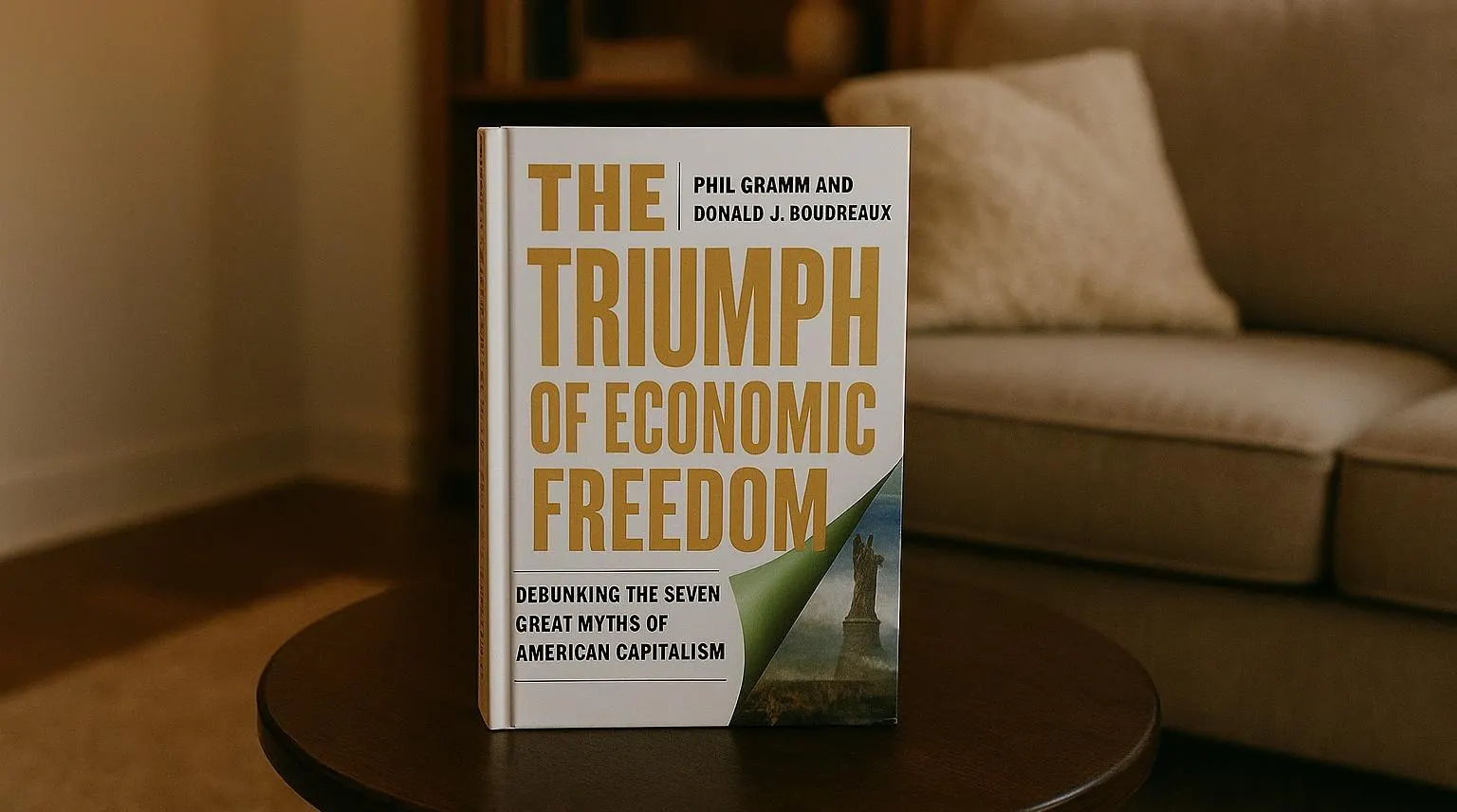By Contributor,Susan E. Dudley
Copyright forbes

Book cover image on a coffee table
At a time when politicians of both parties are seeking ever greater government intervention in private activities, The Triumph of Economic Freedom is a gust of intellectual fresh air. Chapter by chapter, the book by former Texas Senator Phil Gramm and George Mason University Professor Donald J. Boudreaux methodically dismantles seven myths that have clouded public discourse and policymaking for decades.
The authors tackle claims that capitalism exploits workers, increases poverty and exacerbates inequality; that trade has hollowed out manufacturing; that progressive-era regulation saved America from the Great Depression; and that inadequate regulation caused the financial crisis. But rather than relying on abstract economic theory, they lean heavily on empirical evidence. Each chapter begins with a balanced argument in favor of the “myth,” followed by a careful analysis that refutes each narrative and highlights the failure of policies that are based on them.
Both authors are experienced writers and educators, and they make their case in clear and engaging prose. The Triumph of Economic Freedom is a powerful and readable book that makes a compelling case for different approaches to today’s policy challenges than current politicians of either party are embracing.
Myth-Busting with Data, Not Dogma
The Triumph of Economic Freedom is not a polemic, but a call for intellectual honesty, and one of the book’s strengths is its commitment to data. The first chapter on the Industrial Revolution, for example, relies on British statistics to present a very different picture of the condition of the poor during the shift from country life to work in urban factories than that portrayed in English literature and by authors like Engels and Marx. While the standards of living during the 19th century seem miserable by modern standards, Gramm and Boudreaux show that “by every measured index of wages, nutrition, literacy, morbidity, mortality, and human flourishing, the Industrial Revolution…broke the stagnation and crippling poverty that” had been the poor’s lot for more than a thousand years.
The second chapter moves to America to debunk the myth that laissez faire policies in the Gilded Age led to powerful monopolies that exploited workers and consumers. It acknowledges “the core economic dangers of monopoly power—namely, restricted output and higher prices,” but shows that “by virtually every economic measure, including production, real wages, literacy, and mortality, public prosperity and well-being grew faster” during the late 19th and early 20th centuries than before. Indeed, evidence suggests that this period was characterized by intense competition driven by new technologies, sources of supply, and operating improvements. The authors argue that government tariffs and regulations imposed during the Progressive Era in response to the perceived dominance of some firms are what squelched competition, slowed innovation, and harmed consumers. Bipartisan reforms in the 1970s and 80s reversed those policies by deregulating airlines, trucking, railroads, energy and communications, clearing the way for the Internet, accessible air travel, and other innovations we take for granted today.
MORE FOR YOU
Subsequent chapters on the Great Depression and financial crisis similarly rely on empirical evidence to argue that, rather than indicating a failure of capitalism, they were longer and more painful than other recessions due to the monetary, fiscal, and regulatory policies of the federal government. They take on concerns about income inequality and poverty, arguing that capitalism has been the most effective system for reducing poverty globally. They make a compelling case that Census data, by ignoring transfer payments and taxes, do not reflect consumption nor overall living standards. After accounting for those, income inequality in America is not only comparable to other developed countries but lower than it was in 1947.
Offering Lessons for Today’s Challenges
While the book provides an empirical, historical evaluation of seven great policy debates, it offers lessons that couldn’t be more relevant today. The chapter on trade debunks the current administration’s assertions that trade deficits (which occur when Americans purchase more foreign goods and services than U.S. producers sell to foreigners) harm American manufacturers, workers and consumers. They present data and graphs that show there is “no correlation between trade deficits and job creation” and point out that “since 1975, when America last ran an annual trade surplus, the inflation-adjusted value of America’s capital stock has risen 179 percent.”
Perhaps nowhere are their insights more important than for the emerging area of artificial intelligence, where politicians on both sides of the aisle are calling for government intervention to protect against dominant firms, job losses, privacy, and environmental degradation. They’re more optimistic, noting that “the history of the Industrial Revolution should reassure us that if humankind could not only endure but prevail in the face of those traumatic changes, we can surely cope with the changes that new technology will produce in areas like artificial intelligence.”
The authors argue that capitalism’s greatest virtue is its capacity for self-correction and experimentation. Markets are disruptive, but they are also dynamic, and government interventions (tariffs, regulation, antitrust policies that aren’t focused on consumer welfare, etc.) can stifle the very innovation that drives progress. Rent control, minimum wage laws, and protectionist trade policies, however well-intentioned they may be, ultimately have counterproductive efforts that hurt the very people they aim to help.
In a time when economic freedom is under siege from both the left and the right, this book is a timely reminder of what’s at stake. It’s a must-read for policymakers, students, and anyone who wants to understand the causes of a prosperous and flourishing society, and the policies that can make or break it.
Editorial StandardsReprints & Permissions



